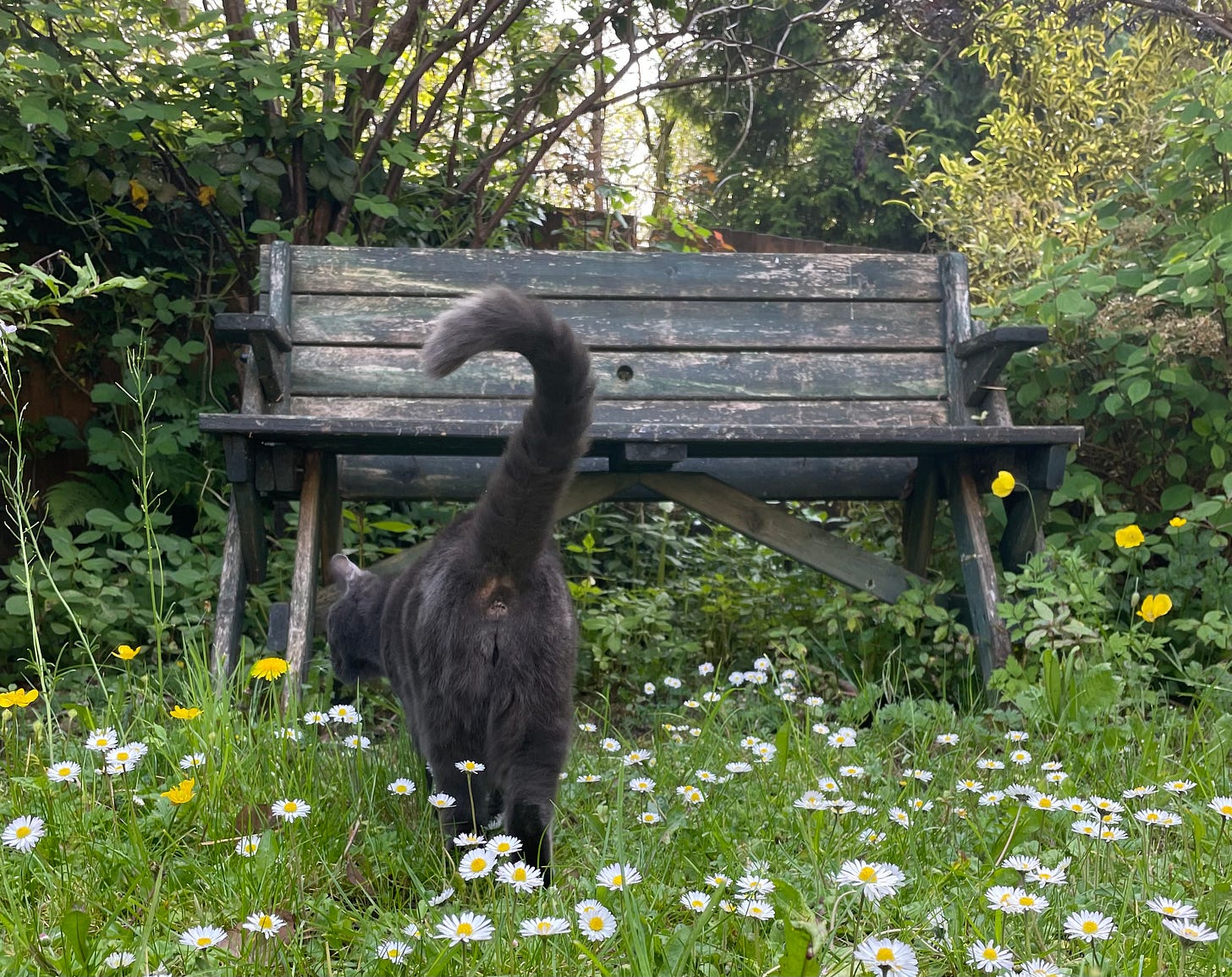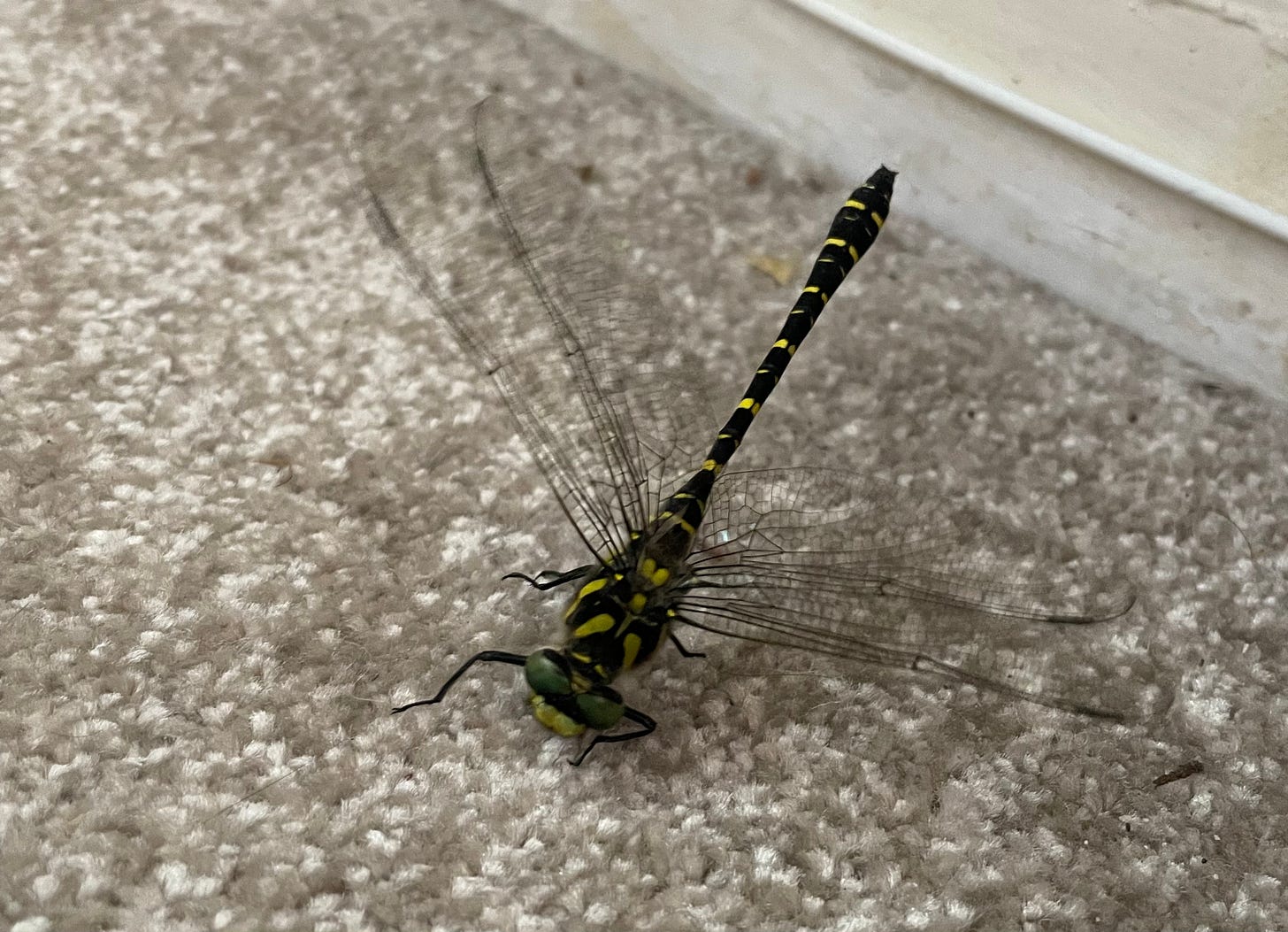On empathy (a request for my cats to please stop murdering things)
Where the Eyes Go, The Car Goes Part 3: In which Hari discusses the need for connection, the cozy suburban life of dragonflies, and engages in lateral thinking.
Good day to you, loyal reader. I hope this article finds you well, and your head full of exciting things. You may be thinking to yourself: How exciting, I was not expecting such a triumphant return to Hari’s ongoing series about mass communication and the environment so soon. I was certain she would avail us as to how her adventures in natural dyeing went before she came back to such an insightful and obviously arduous column for her to write. If you just joined me because of
’s very generous sharing of my column (thank you, by the way, Julie - you are far too kind to me), please don’t worry and keep reading - there is a small sequel to the story you read about half-way down this article.Reader, it rained while we were trying to dye the clothes. We had to leave the allotment and go home. We literally abandoned them in the pot they were in. At least the pigments will have plenty of time to permeate. So, I’m afraid, you shall have to wait a little bit longer because, true to my own personal branding, I’m afraid life just didn’t line up that way. Anyway, welcome back to Where the Eyes Go, The Car Goes, my article series on media and branding theory and how it relates to the way we see our environment.
I would like to share a concern. My cat keeps attacking the local wildlife. If you have read some of my previous work, you will know this is a rare but distressing occurrence. However, we have had the misfortune of her bringing back not one, but two golden-ringed dragonflies in the space of two days. I’ve popped a picture of one of the poor little fellas down below. This little guy got away with a little wing damage, but nothing major – I managed to rescue him in time. He flew away quite happily. The one yesterday, though, he was snapped in half. He’s not going anywhere anytime soon. Golden-ringed dragonflies are the longest species of dragonfly that live in the UK, and are not uncommon across the country and parts of Europe, but are localised enough for me to feel like she may be facilitating an ecological disaster.
It is our fault, of course; we let her in the back garden. She has free reign over that area. We have a stream behind us, and a small children’s play table that has been repurposed to grow pond plants. What is presumably happening is that the little fellows are coming up from the stream, having a rest at the pond, and then living out their own version of Attack on Titan. I’m distressed because I can’t easily move the pond as things live inside it, but more so I’m distressed because I can’t communicate that Sooty shouldn’t do that. I can tell her it’s bad and that’s she’s not allowed, and hope that she remembers, but I can’t explain that it is in some way morally wrong. I can’t get her to have empathy for the little creatures she so joyfully destroys.
If you read my first Paid Subscriber Special, you will know that I am a PhD student studying the representation of mental ill-health in scripted work. Over the past three and a half years, I have dedicated a lot of time to finding ways of crafting empathy between the audience member and the character with mental ill-health, ways of finding that warm, fuzzy feeling that makes you think: ‘we’re not so different, you and I’. If you read that article, you would know that I have some very specific ideas about how to go about crafting that empathy, and in turn, hopefully aiding in the transformation of people’s attitudes and behaviours over time. It’s not a cure-all, but it’s better than whatever James McAvoy in Split was.
But this isn’t a film studies Substack, reader, you know this; this is a nature Substack. It did get me thinking though: if we want people to treat nature better, maybe we need to empathise with it a little more. Let me tell you something:
That first dragonfly, the one who was killed? He was named James. He had a wife named Jenny and a son named Jonah. They were principled and deeply religious members of their community, but not the wrong sort of religious that was nasty to minorities, the sort of religious that helped their neighbours and brought food to the local church buffet, even if someone else said that it had already been sorted. The food was also gluten free, in case anyone had any allergies that no one was aware of. James was a business-fly who hired young male dragonflies without qualifications and ran the local AA meetings. He believed that no dragonman was beyond hope. He was searching for a spot for his sister to lay eggs when the titan struck. His family have not seen him in days, they are beginning to give up hope.
I don’t think you’re taking this seriously, reader.
I’m sure one or two of you, the ones with neurodivergent tendencies who anthropomorphise everything, are probably crying right now. I’m not judging you, reader, I’m right there with you. I’m sad for James’ made-up family too. The rest of you, however, are probably looking at me incredulously. If you could, you’d tell me I was onto a loser. I can’t get a cat to buy into that because cats can’t understand complex human language, and I can’t get a human to buy into it either. Dragonflies just fly about, mate, lay eggs, eat and die. What is this, the 1970s?
We can’t ask everyone to see themselves in every little bug and tree. That would be silly. The dragonfly in question may well have had a very complex social life – though, they are not a good example, actually, because the general consensus is that they are fairly solitary – but either way, most people tend to agree (whether they are right or not) that animals don’t think like we do, and they can’t imagine a world outside of children’s books where they can. We might try to get people to imagine things are the way they are in children’s books, but lots of sad and soulless people will tell you that things simply aren’t that way at all, and that you personally need to grow up for trying to get them to think that they are. We all agree Watership Down is pretty traumatising, but people still go about destroying forestry and threatening to murder innocent families of bunnies that happen to live on their plots. (As a tragic, but rather more satisfying end to the bunny story from a few weeks ago, by the way, a mother fox and her three cubs came and ate them. The men at the allotment are now threatening to kill them, but they haven’t because even they aren’t that evil).
If we can’t emotionally connect because of something’s weird bug eyes, or indeed a tree’s complete lack of eyes, then how do we create emotional connection? I don’t know what the answer to this is, but I have a few ideas, and I would like to dedicate some time to finding out. Maybe through a sub-series within a wider, pre-existing series on changing people’s attitudes to the environment. A meta series, perhaps. Maybe we’ll make references to popular media, and self-referential jokes at I - the protagonist’s - expense. Self-aware. Irreverent. Fourth wall breaking. I’ll be like an eco-Deadpool.
Next week: why I think climate-conscious apocalypse fiction is a waste of time.
You might think the solution to all this is to just stop Sooty going out, but she pulls all her fur out when we try to keep her in the house and, as she didn’t ask to be born or indeed to live with us, I don’t think it’s fair to keep her in distress. I also don’t think that would solve the wider problem of making sure people connect with nature in a meaningful way. It would just make my cat sad, which would, indeed, make me sad. I wonder if cats can understand the pain of others. Maybe they’re like us and most of them can only really empathise with other mammals. Maybe if I got my mother to dress up like a big dragonfly, Sooty would begin to see them as her kin, and stop breaking their tiny spines. I don’t think they have spines, actually. I think they have exoskeletons. But you know what I mean.
If any of you have any advice for relocating a small pond, please let me know.
In the coming weeks, Nature with Hari Berrow will be giving over some time to explore celebrity and branding theory as it relates to nature and the environment. We’ll be exploring the ongoing rebrand of bees, the nature of populism, and much more. I would love it if these discussions were not just fielded by me. We already have some brilliant writers set up to contribute something to the project, but if you would like to contribute a piece to the discussion on my page, or post something on your own blog as part of ‘Where the Eyes go, the Car Goes’, please get in touch.




Is it bad that I LOL’d at the fate of the bunnies? What a case of nature having the last laugh. After all, foxes are people too. Thanks for another thought-provoking post.